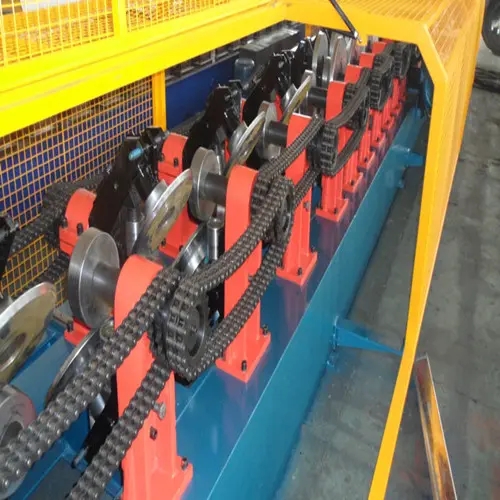
The C-Shaped Steel Roll Forming Machine An Overview
In the modern manufacturing landscape, efficiency, precision, and automation are pivotal. One of the technologies that epitomizes these traits is the C-shaped steel roll forming machine. This machine is integral in producing C-shaped steel sections, commonly used in various construction and industrial applications.
What is a C-Shaped Steel Roll Forming Machine?
A C-shaped steel roll forming machine is a type of equipment used to manufacture C-shaped steel profiles from flat steel sheets. The process begins with feeding flat steel into the machine, where it is gradually formed into the desired shape through a series of rollers. These rollers are designed to bend and shape the steel into a consistent C profile, which is crucial for ensuring structural integrity and uniformity.
The benefits of using such machines extend beyond mere efficiency; they also enhance the product's strength and quality. This is achieved through a meticulous process of cold forming, where the steel is shaped at room temperature. Cold forming not only preserves the material properties of the steel but also ensures that the end products have superior strength compared to those produced through traditional methods.
Components of the C-Shaped Steel Roll Forming Machine
The machine consists of several key components that work in harmony to achieve the final output
1. Feeding Section This initial part of the machine guides the flat steel into the roll forming system. Accurate feeding is critical for the consistency of the final product.
2. Rollers The heart of the machine consists of multiple rollers arranged in a specific sequence to shape the steel. Each roller has a specific function – bending, curving, or cutting – to achieve the desired C profile.
3. Hydraulic System Many modern machines incorporate hydraulic systems that exert precise control over the forming process, enhancing both speed and accuracy.
4. Cutting Mechanism Once the steel has been shaped into a C profile, it is typically cut to length in accordance with specifications. This component can be designed for both manual and automatic operation, offering flexibility for different production needs.

5. Control System Advanced machines come equipped with computerized control systems that allow operators to program specifications, monitor production in real-time, and make adjustments as necessary.
Applications of C-Shaped Steel Profiles
C-shaped steel sections produced by these machines are extensively used across various industries. They are commonly utilized in building frameworks, trusses, and supports due to their ability to bear significant loads. Additionally, they find applications in manufacturing pallets, racks, and shelving systems. The versatility of C-shaped profiles makes them essential in automotive, shipbuilding, and industrial machinery sectors as well.
Advantages of Using C-Shaped Steel Roll Forming Machines
1. Efficiency The automatic operations of these machines enable high production rates, significantly reducing manufacturing time compared to manual methods.
2. Cost-Effectiveness Producing C sections in bulk leads to reduced material waste and lower labor costs, ultimately contributing to savings in production.
3. Customization Modern C-shaped steel roll forming machines can produce various sizes and thicknesses, allowing manufacturers to tailor products to specific project requirements.
4. Durability Products manufactured through cold forming retain the inherent strength properties of steel, ensuring long-lasting performance.
5. Reduced Labor Automation minimizes the reliance on manual labor, providing a safer working environment and allowing operators to focus on more complex tasks.
Conclusion
The C-shaped steel roll forming machine exemplifies the advancements in manufacturing technology, combining efficiency, precision, and adaptability. As industries evolve, the demand for specialized steel profiles continues to grow, highlighting the importance of such machines in meeting market needs. In embracing these innovations, manufacturers position themselves not only to thrive in today’s competitive landscape but also to contribute to the development of robust infrastructures and products that stand the test of time.